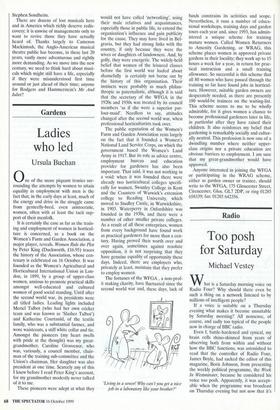Gardens
Ladies who led
Ursula Buchan
One of the more piquant ironies sur- rounding the attempts by women to attain equality in employment with men is the fact that, in the early days at least, much of the energy and drive in the struggle came from genteelly-bred, even aristocratic, women, often with at least the tacit sup- port of their menfolk.
It is certainly the case as far as the train- ing and employment of women in horticul- ture is concerned, as a book on the Women's Farm and Garden Association, a major player, reveals. Women Rule the Plot by Peter King (Duckworth, £16.95) traces the history of the Association, whose cen- tenary is celebrated on 16 October. It was founded as the Women's Agricultural and Horticultural International Union in Lon- don, in 1899, by a group of upper-class women, anxious to promote practical skills amongst well-educated and cultured women of good social standing. Until after the second world war, its presidents were all titled ladies. Leading lights included Mend Talbot (who had her own cricket team and was known as 'Slasher Talbot') and Katherine Courtauld, of the textile family, who was a substantial farmer, and wore waistcoats, a stiff white collar and tie. Amongst the pioneers (my heart swells with pride at the thought) was my great- grandmother, Caroline Grosvenor, who was, variously, a council member, chair- man of the training sub-committee and the Union's chairman. Her daughter was also president at one time. Scarcely any of this I knew before I read Peter King's account, for my grandmother modestly never talked of it to me.
These pioneers were adept at what they would not have called 'networking', using their male relatives and acquaintances, especially those in public life, to extend the organisation's influence and gain publicity for the cause. They may have lived in Bel- gravia, but they had strong links with the country, if only because they were the wives or daughters of landowners. And, by golly, they were energetic. The widely-held belief that women of the leisured classes before the first world war loafed about shamefully is certainly not borne out by the history of this organisation. Their instincts were probably as much philan- thropic as paternalistic, although it is said that the secretary of the WFGA in the 1920s and 1930s was treated by its council members 'as if she were a superior par- lour-maid'. Needless to say, attitudes changed after the second world war, when professional horticulturists took over.
The public reputation of the Women's Farm and Garden Association rests largely on the fact that it founded a Women's National Land Service Corps, on which the government based the Women's Land Army in 1917. But its role as advice centre, employment bureau and education provider for gardeners has also been important. That said, it was not working in a void: when it was founded there were already two horticultural colleges specifi- cally for women, Swanley College in Kent and the Countess of Warwick's extension college to Reading University, which moved to Studley Castle, in Warwickshire, in 1903. Waterperry in Oxfordshire was founded in the 1930s, and there were a number of other smaller private colleges. As a result of all these enterprises, women from every background have found work as practical gardeners for more than a cen- tury. Having proved their worth over and over again, sometimes against resolute opposition, it is not surprising that they have genuine equality of opportunity these days. Indeed, there are employers who, privately at least, maintain that they prefer to employ women.
The fortunes of the WFGA, a non-prof- it making charity, have fluctuated since the second world war and, these days, lack of 'Living in a sewer! Why can't you get a nice job in a laboratory like your brother?' funds constrains its activities and scope. Nevertheless, it runs a number of educa- tional workshops, training days and garden tours each year and, since 1993, has admin- istered a unique scheme for training mature women. Called Women Returners to Amenity Gardening, or WRAG, this scheme places women in approved private gardens in their locality; they work up to 15 hours a week for a year, in return for prac- tical instruction and a small training allowance. So successful is this scheme that all 80 women who have passed through the training so far have found jobs in horticul- ture. However, suitable garden owners are desperately needed, as there are presently 180 would-be trainees on the waiting-list. This scheme seems to me to be wholly admirable, for it gives women a chance to become professional gardeners later in life, in particular after they have raised their children. It also reinforces my belief that gardening is remarkably socially and cultur- ally neutral. This profession is now one of a dwindling number where neither upper- class origins nor a private education are obvious barriers to employment. I am sure that my great-grandmother would have approved.
Anyone interested in joining the WFGA or participating in the WRAG scheme, either as garden owner or trainee, should write to the WFGA, 175 Gloucester Street, Cirencester, Glos. GL7 2DP, or ring 01285 658339; fax: 01285 642356.


















































































 Previous page
Previous page